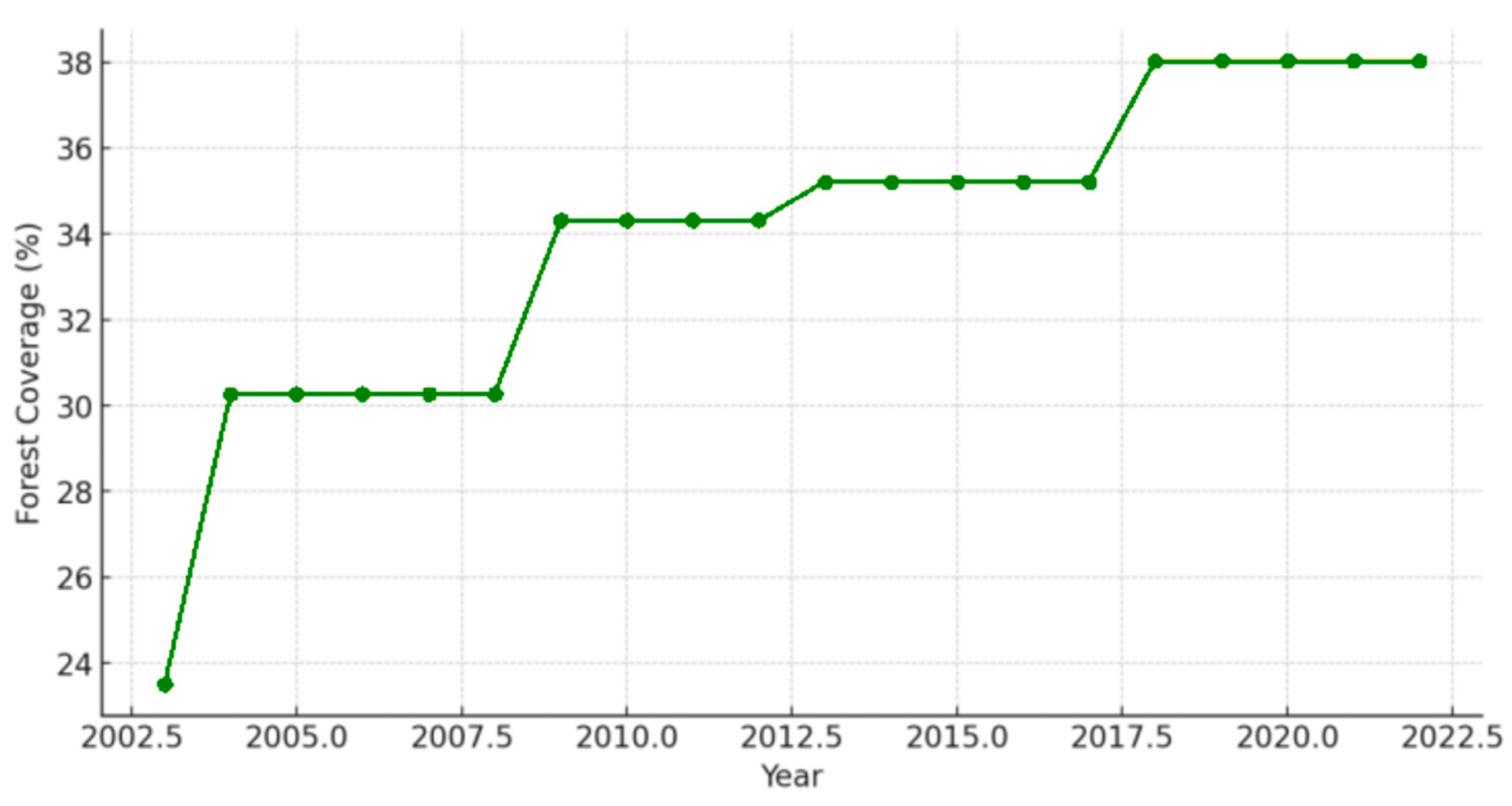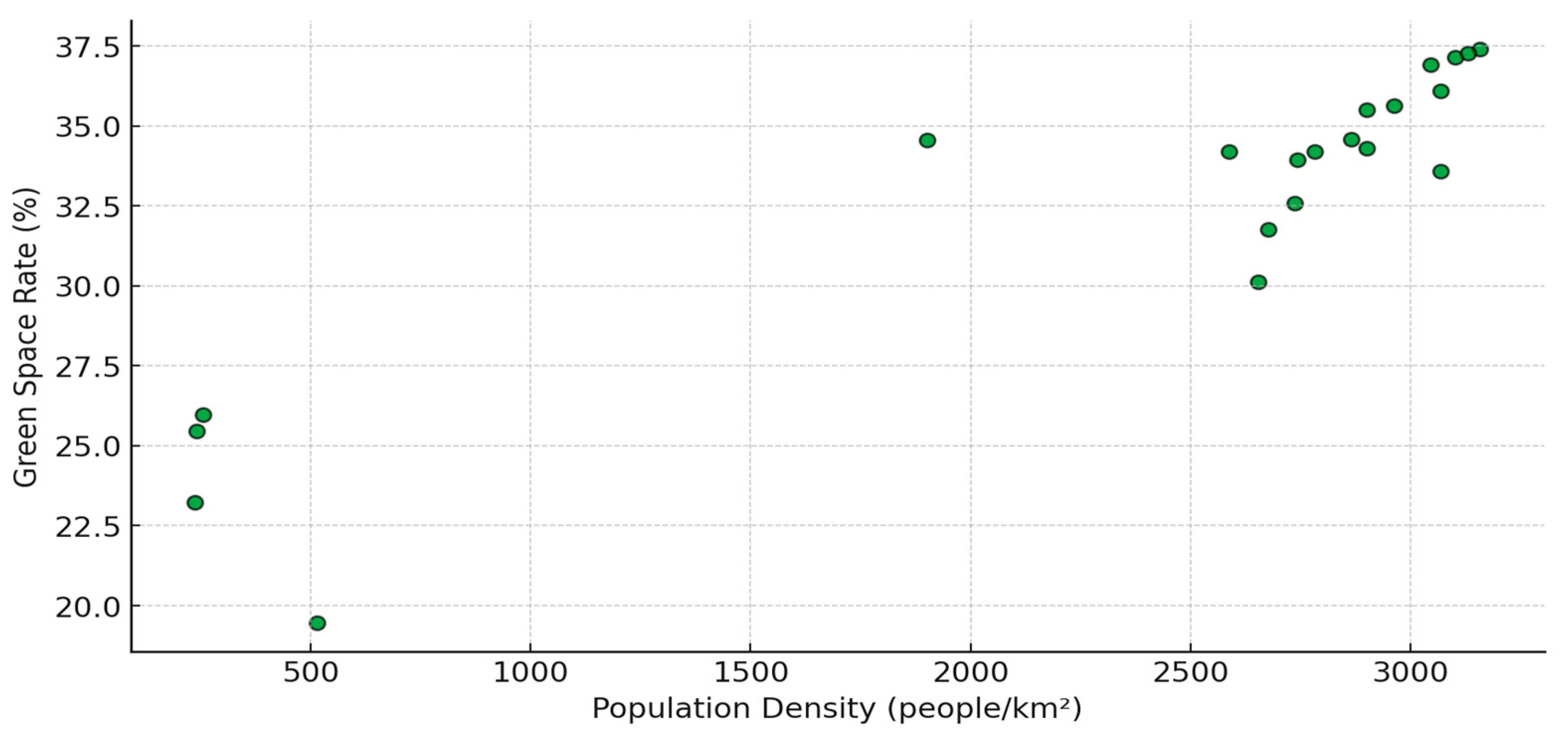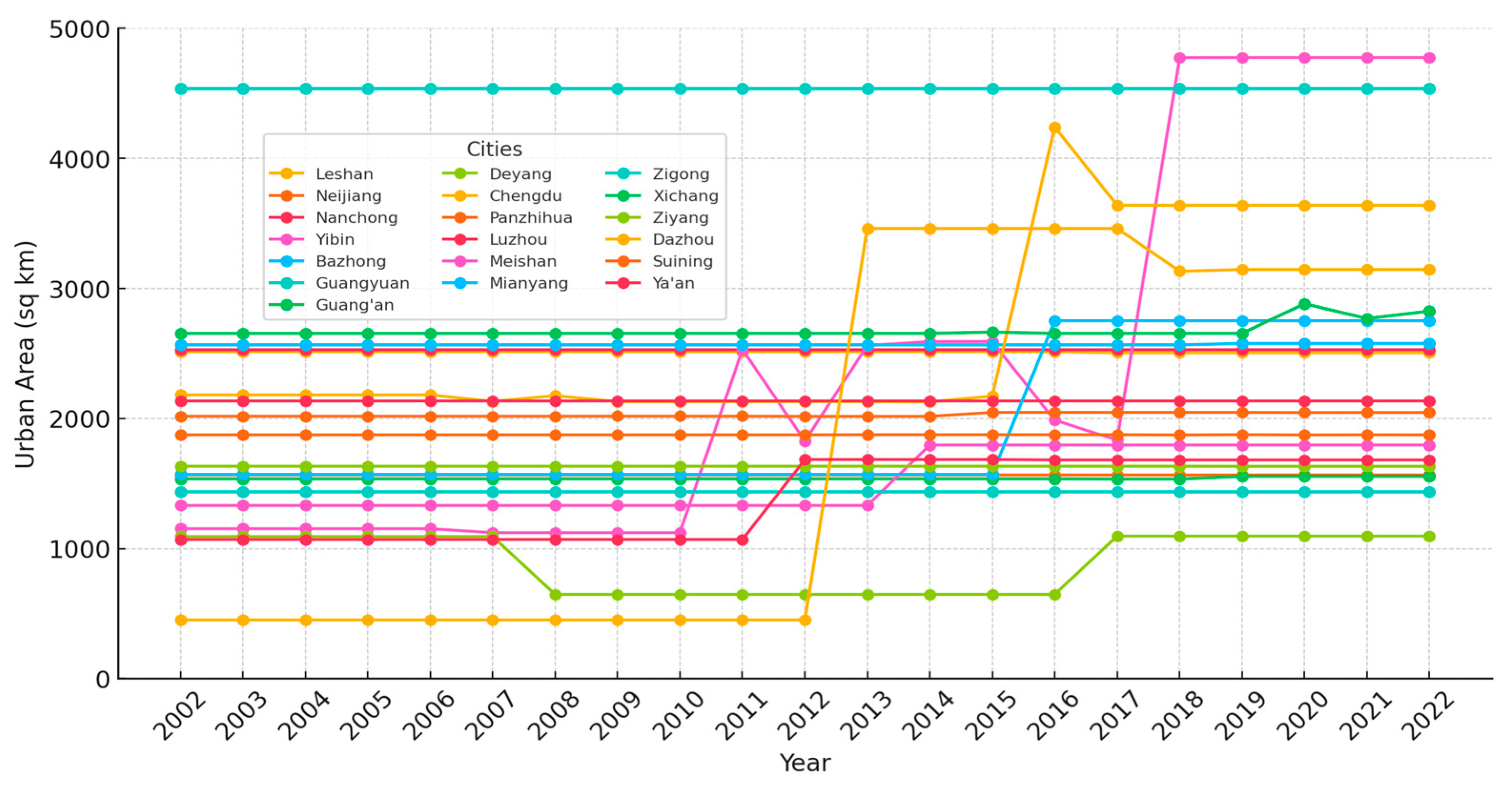Enhancing Urban Sustainability Through Green Infrastructure: Spatiotemporal Analysis of Green Space and Forest Coverage in Sichuan (2002–2022)
Abstract
1. Introduction
1.1. Research Background and Significance
1.2. Problem Statement and Research Gap
1.3. Research Objectives and Contributions
1.4. The Structure of the Paper
2. Materials and Methods
2.1. Study Area Description
2.2. Data Collection and Sources
2.3. Analytical Methods
3. Results
3.1. Spatiotemporal Trends of Green Space and Forest Coverage
3.2. The Relationship Between Urbanisation and Green Infrastructure
3.3. Ecological and Carbon Sequestration Impacts
3.4. Comparative Analysis of Urban vs. Rural Areas
4. Discussion
4.1. Implications for Sustainable Urban Planning
4.2. Policy Interventions and Green Infrastructure Strategies
4.3. Comparison with International Case Studies
4.4. Limitations and Future Research Directions
5. Conclusions
5.1. Summary of Key Findings
5.2. Policy Recommendations
5.3. Implications for Climate Resilience and Carbon Neutrality
5.4. Future Research Prospects
Author Contributions
Funding
Institutional Review Board Statement
Informed Consent Statement
Data Availability Statement
Conflicts of Interest
References
- Benedict, M.A.; McMahon, E.T. Green Infrastructure: Linking Landscapes and Communities, Illustrated ed.; Island Press: Washington, DC, USA, 2006; pp. 20–299. Available online: https://islandpress.org/books/green-infrastructure (accessed on 29 April 2025).
- Kabisch, N.; Qureshi, S.; Haase, D. Human–environment interactions in urban green spaces—A systematic review of contemporary issues and prospects for future research. Environ. Impact Assess. Rev. 2015, 50, 25–34. [Google Scholar] [CrossRef]
- Gómez-Baggethun, E.; Barton, D.N. Classifying and valuing ecosystem services for urban planning. Ecol. Econ. 2013, 86, 235–245. [Google Scholar] [CrossRef]
- Li, X.; Zhou, W.; Ouyang, Z.; Xu, W. Urbanization and urban land expansion in China: A comparative study of Beijing, Shanghai, and Guangzhou. Land Use Policy 2018, 72, 470–479. [Google Scholar] [CrossRef]
- Wang, J.; Zhao, S.; Li, X. Spatiotemporal patterns of urban green infrastructure in response to rapid urbanization: The case of Shanghai, China. Ecol. Indic. 2020, 118, 106724. [Google Scholar] [CrossRef]
- Tian, Y.; Jim, C.Y.; Wang, H.; Zhang, X. Urban green space dynamics and their impact on environmental sustainability: A comparative study in Chinese megacities. Sustain. Cities Soc. 2023, 91, 104481. [Google Scholar] [CrossRef]
- Britannica. Sichuan. In Encyclopedia Britannica. Available online: https://www.britannica.com/place/Sichuan (accessed on 29 April 2025).
- World Resources Institute. Global Forest Watch. Available online: https://www.globalforestwatch.org (accessed on 17 April 2025).
- Liu, Z.; Wang, W.J.; Ballantyne, A.; He, H.S.; Wang, X.; Liu, S.; Ciais, P.; Wimberly, M.C.; Piao, S.; Yu, K.; et al. Forest disturbance decreased in China from 1986 to 2020 despite regional variations. Commun. Earth Environ. 2023, 4, 15. [Google Scholar] [CrossRef]
- Li, X.; Li, W.; Xu, H.; Zhao, L. Assessing urban forest carbon sequestration using remote sensing and ecological indicators. Ecol. Indic. 2020, 110, 105932. [Google Scholar]
- Fan, P.; Ouyang, Z.; Basnou, C.; Chen, J. Integrating urban green infrastructure for climate adaptation: A socio-ecological perspective. Ecol. Indic. 2019, 98, 39–49. [Google Scholar] [CrossRef]
- Haase, D.; Larondelle, N.; Andersson, E.; Artmann, M.; Borgström, S.; Breuste, J.; Gomez-Baggethun, E.; Gren, Å.; Hamstead, Z.; Hansen, R.; et al. A quantitative review of urban ecosystem service assessments: Concepts, models, and implementation. Ambio 2014, 43, 413–433. [Google Scholar] [CrossRef] [PubMed]
- Viña, A.; Chen, X.; McConnell, W.J.; Liu, W.; Xu, W.; Ouyang, Z.; Liu, J. Effects of conservation policy on China’s forest recovery. Sci. Adv. 2016, 2, e1500965. [Google Scholar] [CrossRef] [PubMed]
- Zhang, Y.; Li, Y.; Wang, Y. Very Rapid Forest Cover Change in Sichuan Province, China: 40 Years of Change Using Images from Declassified Spy Satellites and Landsat. Remote Sens. 2021, 13, 4611. [Google Scholar] [CrossRef]
- Li, J.; Wang, L.; Huang, Y. Spatiotemporal Changes in Ecosystem Service Values in Sichuan Province, China. Front. Environ. Sci. 2022, 10, 931830. [Google Scholar]
- Sichuan Provincial People’s Government. The 14th Five-Year Plan for Integrated Development of the Chengdu Plain Economic Zone; Sichuan Provincial People’s Government: Chengdu, China, 2021; Available online: https://www.seetao.com/details/89057.html (accessed on 29 April 2025).
- Chen, L.; Wang, X.; Zhao, J.; Wu, J. Urban green space dynamics and ecological resilience: Insights from spatial—temporal modeling. Ecol. Indic. 2021, 123, 107304. [Google Scholar]
- Wang, X.; Li, A. Forest coverage dynamics and biodiversity conservation in Sichuan Province. For. Ecol. Manag. 2021, 498, 119302. [Google Scholar]
- Liu, H.; Chen, J. Urban green space expansion and its impact on urban heat island mitigation: A case study in Sichuan Province. Urban For. Urban Green. 2022, 78, 127072. [Google Scholar]
- The Guardian. The Five-Minute City: Inside Denmark’s Revolutionary Neighbourhood. 10 December 2024. Available online: https://www.theguardian.com/lifeandstyle/2024/dec/10/the-five-minute-city-inside-denmarks-revolutionary-neighbourhood (accessed on 29 April 2025).
- Beatley, T. Handbook of Biophilic City Planning & Design; Island Press: Washington, DC, USA, 2016. [Google Scholar]
- Lin, Z. Ecological urbanism in East Asia: A comparative assessment of two eco-cities in Japan and China. Landsc. Urban Plan. 2018, 179, 90–102. [Google Scholar] [CrossRef]
- Niemelä, J. Ecology of urban green spaces: The way forward in answering major research questions. Landsc. Urban Plan. 2014, 125, 298–303. [Google Scholar] [CrossRef]
- Buchel, S.; Frantzeskaki, N. Citizens’ voice: A case study about perceived ecosystem services by urban park users in Rotterdam, the Netherlands. Ecosyst. Serv. 2015, 12, 169–177. [Google Scholar] [CrossRef]
- Sichuan Provincial People’s Government. Communique on the Ecological Environment of Sichuan Province (2002–2022). Sichuan Provincial People’s Government. 2023. Available online: https://www.sc.gov.cn/10462/10758/10760/10765/2023/3/14/ed13652666fc41dd820f009d805b7d79.shtml (accessed on 29 April 2025).










| Variable | Description | Source |
|---|---|---|
| Forest Coverage (%) | Percentage of land covered by forests in Sichuan Province | National Forestry Database |
| Urban Green Space Rate (%) | Proportion of urban areas covered by green space | China Urban Construction Database |
| Population Density (people/km2) | Number of people per square kilometre in Sichuan Province | |
| Urban Area (km2) | Total built-up area in Sichuan Province |
| Method | Strengths | Limitations | Suitability for This Study |
|---|---|---|---|
| NDVI + GIS | High spatiotemporal consistency; well-validated vegetation indicator | Limited in detecting species diversity or vertical structure | Long-term landscape change tracking |
| OLS Regression | Simple and interpretable; baseline for linear relationships | Ignores spatial heterogeneity | Preliminary association analysis |
| GWR | Captures spatial variation in relationships; local modelling | Computationally intensive; sensitive to bandwidth choice | Uncover localised urban green dynamics |
| Random Forest (RF) | High predictive accuracy; handles nonlinearities | Black-box nature; lacks spatial interpretability | Less suitable for spatially explicit policy implications |
| Support Vector Machine (SVM) | Good with high-dimensional data; robust classification | Requires kernel tuning; weak in spatiotemporal explanation | Not ideal for urban pattern explanation |
| Deep Learning (e.g., CNNs) | Extracts complex features from large imagery datasets | Requires large labelled datasets; low interpretability | Overkill for limited variable analysis |
| Policy Area | Key Measures | Goals | Challenges |
|---|---|---|---|
| Urban Green Space Planning | Green space system, park expansion | Increase green space, improve urban ecology | Land conflicts, rapid urbanisation |
| Forest Protection and Restoration | Forest protection, reforestation, Grain for Green Programme | Restore forests, protect biodiversity | Funding, illegal logging |
| Ecological Protection Zones | Ecological red lines, no-development zones | Protect ecosystems, biodiversity hotspots | Balancing development, enforcement |
| Green Building and Low-Carbon Cities | Green building standards, sustainable urban design | Reduce emissions, promote sustainability | High costs, limited awareness |
| Public Participation and Awareness | Ecological education, community engagement in green space management | Raise awareness, increase participation | Limited outreach, public reluctance |
| Key Area | Findings |
|---|---|
| Urban Green Space Changes | Urban green space coverage increased in some cities but declined in high-density urban centres due to rapid urban expansion. |
| Forest Coverage Trends | Overall forest coverage fluctuated, with noticeable afforestation efforts but losses in peri-urban areas due to development. |
| Urbanisation Impact | Urban expansion led to a decline in green space and fragmented forest areas, particularly in rapidly growing cities. |
| Policy and Management Gaps | Existing policies support green space expansion, but enforcement challenges remain, particularly in balancing economic development and conservation. |
| Sustainability Considerations | Climate change and urban heat island effects highlight the need for stronger green infrastructure and adaptive planning measures. |
| City | Forest Coverage (%) 2002 | Forest Coverage (%) 2022 | Change (%) | Green Space per Capita (m2) 2002 | Green Space per Capita (m2) 2022 | Change (m2) |
|---|---|---|---|---|---|---|
| Chengdu | 36.5 | 40.2 | 3.7 | 9 | 14.5 | +5.5 |
| Mianyang | 38 | 41 | 3 | 8.5 | 13 | +4.5 |
| Zigong | 35 | 38.5 | 3.5 | 7.8 | 12 | +4.2 |
| Panzhihua | 34 | 37.5 | 3.5 | 8 | 12.5 | +4.5 |
| Deyang | 36 | 39.5 | 3.5 | 8.2 | 13 | +4.8 |
| Research Focus | Description |
|---|---|
| Remote Sensing and GIS Analysis | Utilise advanced spatial analysis tools to track real-time changes in green space and forest coverage. |
| Carbon Sequestration and Climate Impact | Assess the role of urban green spaces and forests in mitigating carbon emissions and climate change. |
| Comparative Policy Analysis | Study green space policies across different cities and regions for best practices and effectiveness. |
| Biodiversity and Ecosystem Services | Examine how urban forests and green spaces contribute to biodiversity conservation and ecosystem benefits. |
| Public Participation and Urban Planning | Investigate community engagement strategies in urban green space management and decision-making. |
Disclaimer/Publisher’s Note: The statements, opinions and data contained in all publications are solely those of the individual author(s) and contributor(s) and not of MDPI and/or the editor(s). MDPI and/or the editor(s) disclaim responsibility for any injury to people or property resulting from any ideas, methods, instructions or products referred to in the content. |
© 2025 by the authors. Licensee MDPI, Basel, Switzerland. This article is an open access article distributed under the terms and conditions of the Creative Commons Attribution (CC BY) license (https://creativecommons.org/licenses/by/4.0/).
Share and Cite
Xiao, L.; Mokhtar, N.A.; Sulaiman, M.K.A.M.; Khalit, N.A. Enhancing Urban Sustainability Through Green Infrastructure: Spatiotemporal Analysis of Green Space and Forest Coverage in Sichuan (2002–2022). Sustainability 2025, 17, 5135. https://doi.org/10.3390/su17115135
Xiao L, Mokhtar NA, Sulaiman MKAM, Khalit NA. Enhancing Urban Sustainability Through Green Infrastructure: Spatiotemporal Analysis of Green Space and Forest Coverage in Sichuan (2002–2022). Sustainability. 2025; 17(11):5135. https://doi.org/10.3390/su17115135
Chicago/Turabian StyleXiao, Lin, Noor Aisyah Mokhtar, Mohd Khairul Azhar Mat Sulaiman, and Nur Athirah Khalit. 2025. "Enhancing Urban Sustainability Through Green Infrastructure: Spatiotemporal Analysis of Green Space and Forest Coverage in Sichuan (2002–2022)" Sustainability 17, no. 11: 5135. https://doi.org/10.3390/su17115135
APA StyleXiao, L., Mokhtar, N. A., Sulaiman, M. K. A. M., & Khalit, N. A. (2025). Enhancing Urban Sustainability Through Green Infrastructure: Spatiotemporal Analysis of Green Space and Forest Coverage in Sichuan (2002–2022). Sustainability, 17(11), 5135. https://doi.org/10.3390/su17115135







